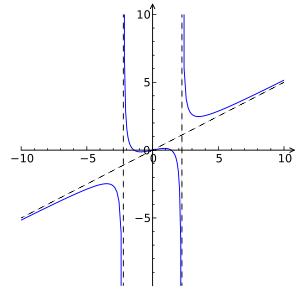Calculus/Rational functions
Rational function is "any function which can be defined by a rational fraction, i.e. an algebraic fraction such that both the numerator and the denominator are polynomials".
Definition. A function is called a rational function if and only if it can be written in the form
where and are polynomials in and is not the zero polynomial. The domain of a function is the set of all points for which the denominator is not zero.
It can be proved that sum, product, and quotient (except division by the zero polynomial which will cause the function to be undefined) of rational functions are rational functions.
Examples
[edit | edit source]The rational function is not defined at . It is asymptotic to , i.e. gets closer and closer to , as approaches positive or negative infinity.
The rational function is defined for all real numbers, but not for all complex numbers, since if were a square root of (i.e. the imaginary unit or its negative), then formal evaluation would lead to division by zero: , which is undefined.
Every polynomial function is a rational function with . A function that cannot be written in this form, such as , is not a rational function. The adjective "irrational" is not generally used for functions.
Sketch a graph of a rational function
[edit | edit source](1)Let's sketch the graph of .
First, we must avoid because anything can not be divided by 0. Thus x should not be 0 in the equation.
Now we just plug in some values of x. The result is as follows:
As x get large the function itself gets smaller and smaller. Here is the graph of .

References
[edit | edit source]- Wikipedia article on rational function
- Paul's Online Math Notes"Rational Functions"




































